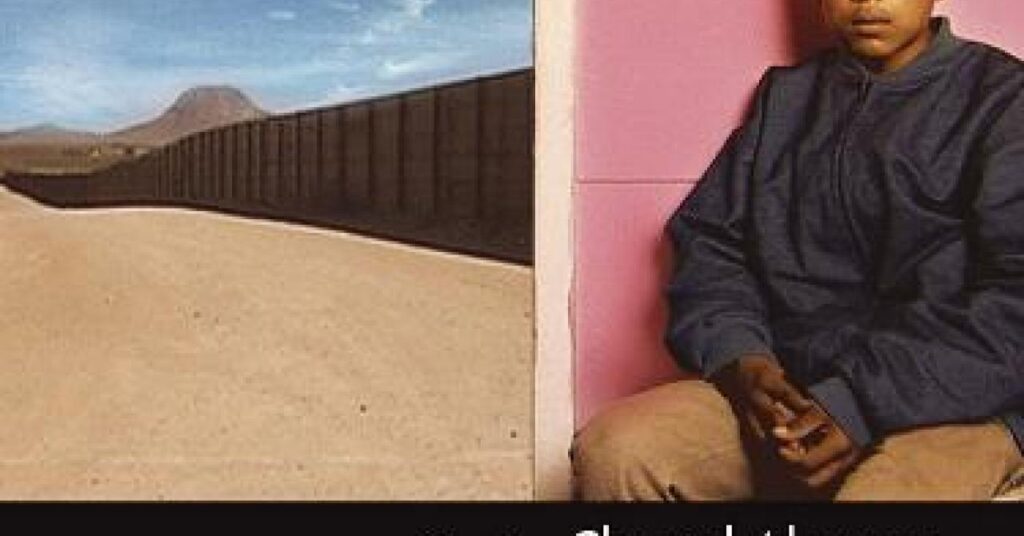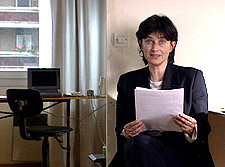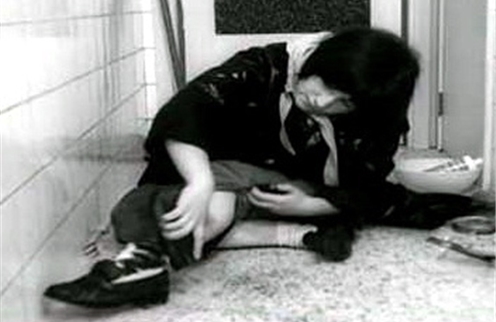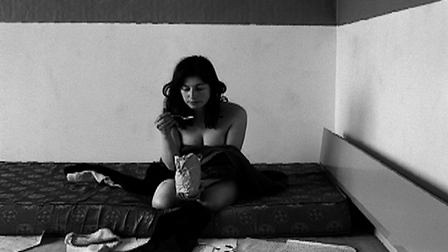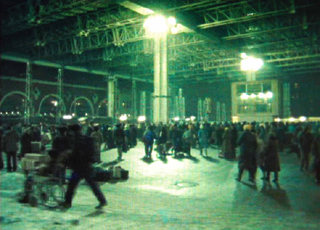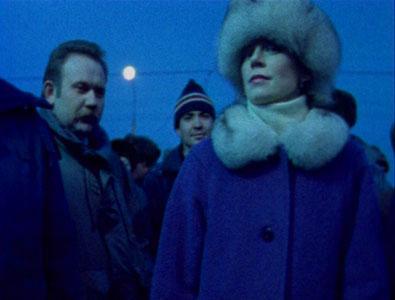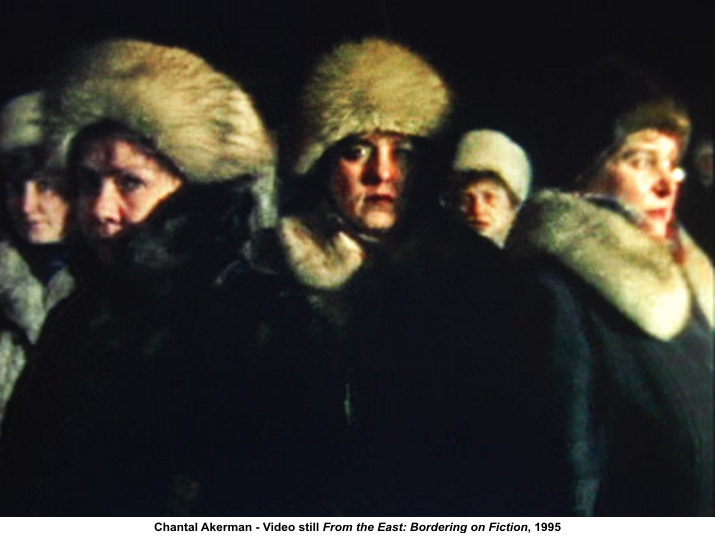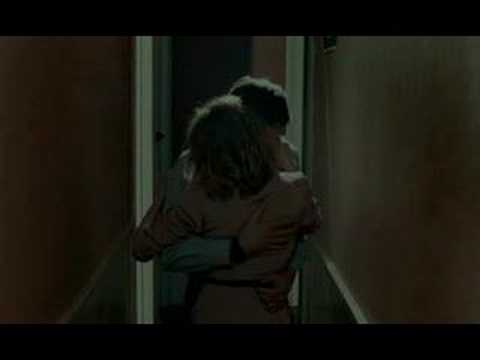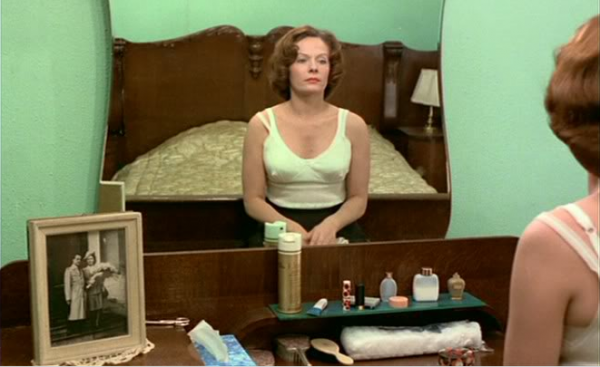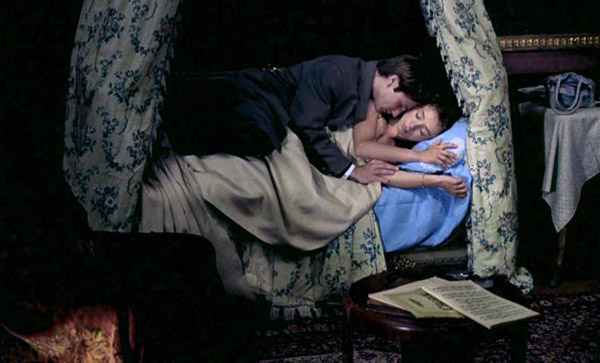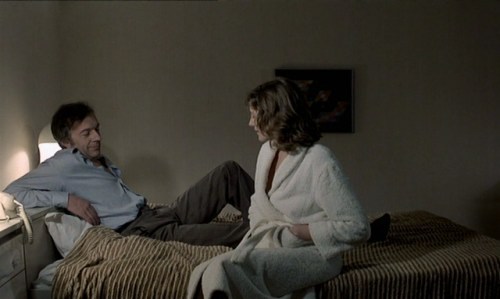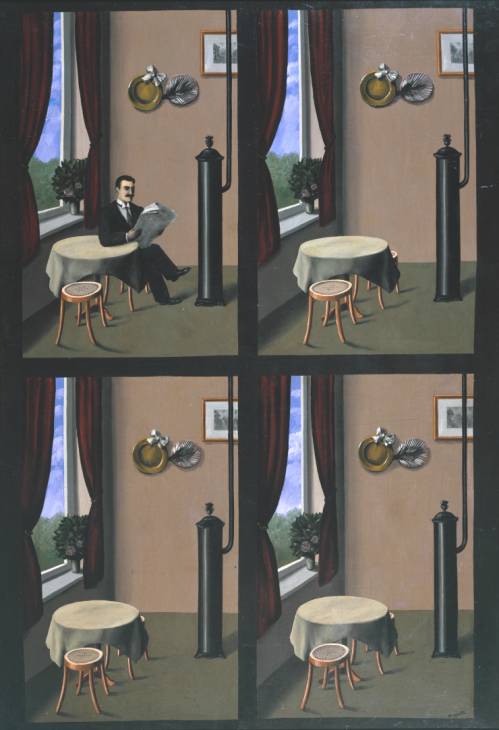I still haven’t recovered from the rude shock of hearing about the suicide of Chantal Akerman on October 6, 2015.
The following was originally published in Retrospektive Chantal Akerman, a publication of the Viennale/Austrian Filmmuseum, 2011, and the second issue of the online Lola (lolajournal.com), 2012. — J.R.
Does one’s integrity ever lie in what he is not able to do? I think that usually it does, for free will does not mean one will, but many wills conflicting in one man [sic]. — Flannery O’Connor
If I have a reputation for being difficult, it’s because I love the everyday and want to present it. In general people go to the movies precisely to escape the everyday. — Chantal Akerman
A yearning for the ordinary as well as the everyday runs through Akerman’s work like a recurring, plaintive refrain. It is a longing that takes many forms: part of it is simply her ambition to make a commercially successful movie; another part is the desire of a self-destructive, somewhat regressive neurotic — Akerman herself in Saute ma ville (1968), La chambre (1972), Je, tu, il, elle (1974), and L’homme à la valise (1983); Delphine Seyrig in Jeanne Dielman, 23 Quai de Commerce, 1080 Bruxelles (1975); Aurore Clement in Les rendez-vous d’Anna (1978); Circé Lethem in Portrait d’une jeune fille de la fin des années 60 à Bruxelles (1993) — to go legit and be like “normal” people. Je, tu, il, elle and Les rendez-vous d’Anna both feature a bisexual heroine who wants to either resolve an unhappy relationship with another woman or to go straight; in Saute ma ville, Je, tu, il, elle, Jeanne Dielman, and L’homme à la valise, the desire to be “normal” is largely reflected in the efforts of the heroine simply to inhabit a domestic space. (This can occasionally develop certain farcical aspects, such as Akerman covering her ankles as well as her shoes with shoe polish in Saute ma ville, or in practically all of her 1984 J’ai faim, j’ai froid, the opening sketch of Paris vus par…20s ans après — an entire coming-of-age film compressed into a dozen frenetic, hilarious, and ultimately touching minutes.)
This desire for normalcy accounts for much of the difficulty of assimilating Akerman’s work to any political program, feminist or otherwise. As an account of domestic oppression and repression, Jeanne Dielman largely escapes these strictures, and Akerman herself has admitted that this film can be regarded as feminist. But she also once refused to allow Je, tu, il, elleto be shown in a gay and lesbian film festival, and more generally has often denied that she considers herself a feminist filmmaker, despite the efforts of certain feminist film critics to claim her as one.
On one hand, her films are extremely varied. Some are in 16-millimeter and some are in 35; some are narrative and some are nonnarrative; the running times range from about 11 minutes to 201 and the genres range from autobiography to personal psychodrama to domestic drama to romantic comedy to musical to documentary — a span that still fails to include a silent, not-exactly-documentary study of a run-down New York hotel (Hotel Monterey, 1972), a vast collection of miniplots covering a single night in a city (Toute une nuit, 1982), and a feature-length string of Jewish jokes recited by immigrants in a vacant lot in Brooklyn at night (Food, Family and Philosophy aka Histoires d’Amérique, 1989), among other oddities.
On the other hand, paradoxically, there are few important contemporary filmmakers whose range is as ruthlessly narrow as Akerman’s, formally and emotionally. Most of her films, regardless of genre, come across as melancholy, narcissistic meditations charged with feelings of loneliness and anxiety; and nearly all of them have the same hard-edged painterly presence and monumentality, the same precise sense of framing, locations, and empty space.
More generally, if I had to try to summarize the cinema of Chantal Akerman, thematically and formally, in a single phrase, “the discomfort of bodies in rooms” would probably be my first choice. And “the discomfort of bodies inside shots” might be the second.
It’s treacherous, of course, to attempt to squeeze an oeuvre as complex and as varied as Akerman’s into anything as formulaic as either of those phrases, and one would have to regard some of their applications rather freely. In the case of D’est (1993), for example, which is most likely her greatest documentary, “rooms” would have to include such wide-open spaces as a crowded railroad station where sleeping bodies are crowded together like so many dropped handkerchiefs and a no less populated and urban bus stop in Moscow where a blanket of snow is falling, Similarly “open” public spaces dominate her equally melancholic, New-York-based News from Home (1977) and Histoires d’Amérique. Toute une nuit, an insomniac’s movie about insomniacs, ends with a sequence in which a couple’s lovemaking is gradually smothered, and all but obliterated from our consciousness, by the hectoring sounds of early-morning traffic outside—a kind of dialectical war between interior and exterior. The tortured aggressiveness of such a moment is part of what Akerman’s filmmaking is about — cold, elegantly symmetrical compositions and brutal sounds being hammered into our skulls with an obstinate will to power that sometimes makes Sylvester Stallone, Arnold Schwarzenegger, Sam Peckinpah, and Clint Eastwood seem like frolicking pussycats in comparison.
Yet it’s hard to be too conclusive about this impression of aggressiveness. By way of contrast, Nuit et jour (1991) reverses the mood of Toute une nuit and initially presents insomnia as a kind of precondition for the utopian romance of Julie and Jack, an infatuated young couple from the provinces who’ve recently come to Paris and live in a small flat near Boulevard Sebastopol — a sentiment expressed at the very outset of the film as they lie together in bed: “Are you sleeping?” “No. Are you?” “No.” “You and I never sleep.” “Never when we are together.” “We like movement better.” “Yes, it’s true.” “When I sleep, I don’t live.” “Neither do I.” “Right now, I prefer living.” “So do I.” A little later their dialogue resumes: “Maybe we should meet people.” “Next year.” “And get a telephone?” “Next year.” And finally, after they make love, this closing exchange: “You must sleep, Jack. You’ll have an accident.” “Next year.” (Later on, when the plot devolves into a variation on Jules et Jim — with a female offscreen narrator to replace Truffaut’s male one — the romantic tone becomes more complicated.)
And in the case of Jeanne Dielman, which is almost certainly Akerman’s greatest fiction film, one would have to admit that the discomfort of the title heroine (Delphine Seyrig) in the rooms of her own flat only begins in earnest during the latter portion of this 201-minute feature, when her routinized life slowly starts to become unraveled. Prior to that, however, one could argue that Jeanne Dielman’s “comfort” is strictly a matter of her keeping an encroaching sense of panic at bay through her compulsive routines — a feeling of panic that eventually overtakes and engulfs her.
There are of course many other exceptions or variations to my formula that could be found in Akerman’s work: “Rooms” may not adequately cover the shopping-mall setting of her musical Golden Eighties (1986), and, for that matter, “discomfort” may be imprecise regarding Les années 80 (1985), its documentary prequel. The shopping mall in Golden Eighties, for instance, sets up an interesting ambiguity about whether one is inside or outside — until the shock of the ending, when the film finally moves out into the open air. The frightening entrapments of La captive (2000), loosely derived from Proust’s La prisonnière and Albertine disparue (as well as evoking, more indirectly, Bresson’s Les dames du Bois de Boulogne through its contemporary setting that evokes the past, and Hitchcock’s Vertigo through its hypnotic, obsessional intensity), may have more to do with brains and feelings than with rooms.
It’s also possible that some of the discomforts found in Nuit et jour, A Couch in New York (1996), and Demain on déménage (2004) may be more a matter of real estate than of rooms per se. Toward the end of Nuit et jour, Julie (Guilaine Londez) and Jack (Thomas Langmann) decide to knock out a wall in their flat, largely as a means of rejuvenating their own relationship, and the physical change in their apartment leads to them to decide to throw a party and join a larger world. A Couch in New York develops its initial premises by crosscutting between dissimilar flats in Manhattan and Paris that are exchanged by a psychotherapist (William Hurt) and a dancer (Juliette Binoche), with many farcical results. And Demain on déménage — another comedy, set almost entirely in a Paris flat — focuses on a young porn author (Sylvie Testud) whose recently widowed mother (Aurore Clement), a piano teacher, moves into the flat, then tries to sell it.
More generally, any close consideration of Akerman’s early films over the first decade of her career — Saute ma ville in Brussels, La chambre, and Hotel Monterey in New York, and then, back in Europe, Je, tu, il, elle, Les rendez-vous d’Anna, and News from Home (which combines images from New York with letters sent from Brussels) — has to acknowledge that the discomfort of bodies in rooms, including Akerman’s own body in the first, second, and fourth (and, more implicitly, in the sixth) of these, is a virtual constant. “I want people to lose themselves in the frame and at the same time to be truly confronting the space,” Akerman once said of Hotel Monterey (as recalled by Michael Koresky, on the DVD of that film released on Criterion’s Eclipse label), which implies that the discomfort of spectators — by which I refer to both their placements and their displacements – is as pertinent as the discomfort of the on-screen bodies.
Like Akerman, whose middle name is Anne, Anna Silver in Les rendez-vous d’Anna is a Belgian Jewish filmmaker; and like Akerman when she made the film, she’s in her late twenties and currently lives in Paris. The film covers a three-day trip she takes by train back to Paris from Cologne, where she introduces a film (an event that we don’t see) and picks up Heinrich (Helmut Griem), a schoolteacher whom she later kicks out of her hotel bed.
On her arrival at the Cologne station, she’s met by Ida (Magali Noël) — the mother of a former fiancé whom she has twice changed her mind about marrying.They converse until evening, when Anna boards the Paris train where she talks to a young German who’s moving to Paris (Hanns Zischler). She gets off the train in Brussels, her hometown, where she’s met by her mother (Léa Massari). Instead of going home, where Anna’s ailing father is already asleep, they check into a hotel where Anna, lying naked beside her mother in bed, describes a lesbian affair she has recently become involved in and feels good about.
The next night, arriving in Paris, she’s picked up by her regular boyfriend (Jean-Pierre Cassel), who takes her to still another hotel. Finding him feverish, she takes a cab to a late-night pharmacie to buy him some medicine. Finally returning home — it’s still dark — Anna plays back the recorded phone messages that have come during her absence.
As a plot, this is obviously quite minimal. Each of the “encounters” described above consists mostly of a monologue — by Heinrich, Ida, the German on the train, Anna herself (to her mother), her French lover, Anna again (when she sings him a song), and the voices on her recording machine (one of which, incidentally, is Akerman’s). In keeping with Akerman’s usual respect for real time, large chunks of this mainly unacted material are simply set down like slabs in front of the viewer without the usual punctuation of camera movements, fades, or dissolves. In a manner recalling Bresson, Antonioni and Straub-Huillet, the locations where these monologues are placed seem featured, lingered over — persisting before, during, after, and even in between the words that are spoken there, constantly threatening to swallow them up.
René Magritte’s painting Man With Newspaper (1927-’28) tells me something about the customary disquiet of Akerman’s world. In it, four panels, two on top and two on the bottom, show the same corner of a sitting room, with one difference: in the first panel a man is seated at the table by the window reading a newspaper, and in the other three panels, neither the man nor the newspaper is in evidence. A narrative is implied between the first and second panel — the disappearance of the man and newspaper — without being confirmed, and we’re left with the eerie fact of three identical “empty” rooms. Similarly, many of Akerman’s settings suggest absence even more than presence.
***
Akerman has described her first film, Saute ma ville, made when she was only 18, as her attempt to do something Chaplinesque. I strongly suspect that she was thinking about Chaplin’s fourth comedy short made at Mutual, his justly celebrated One A.M. (1916), where, apart from a cab driver glimpsed briefly at the very beginning, Chaplin is the only actor in sight, his character arriving at his own home and proceeding to interact catastrophically with the various props he encounters as he tries to get upstairs and go to bed.
Chaplin’s narrative pretext for all the comic chaos engendered is his character’s extreme drunkenness. Akerman — whom we hear manically and wordlessly singing offscreen from the very outset, and is also the only character we see, arriving home and in her case restricting her activities there to a kitchen — provides no narrative context of any kind beyond a certain punklike rebellion against the various domestic rituals that she performs or pretends to perform. These are the same sort of rituals, such as cooking, eating, cleaning up, and polishing shoes that, seven years later, Jeanne Dielman will compulsively embrace, although in this case Akerman’s own frenzied and parodic enactments eventually culminate in a series of offscreen explosions from a gas stove that fulfill the film’s apocalyptic title. (The “cleaning up” that she performs earlier is in such a destructive manner that it recalls the final sequence in Vera Chytilova’s radical Czech farce Daisies, released two years earlier, when the two teenage heroines pretend to “clean up” after their protracted and extravagant food orgy inside a banquet room.)
The two major films of Akerman that follow, both silent , the 65-minute Hotel Monterey and the 11-minute La Chambre — both made in New York during her two or three years there in the early 1970s, and both shot by Babette Mangolte, who introduced her to the North American avant-garde cinema of that period (a major influence), and would subsequently shoot Jeanne Dielman — are also “studies” of solitude, but in this case ones where a minimalist aesthetic and a particular sense of rooms and shots as almost interchangeable predominate.
Akerman appears in almost a third of the films excerpted in her Chantal Akerman par Chantal Akerman (1997) — more if one adds a couple in which we hear her offscreen voice — and one of the fascinations of this critical and selective tour is watching her own gestures being reproduced in other films by some of her actresses. (Aurore Clement nibbling food off a stray hotel tray on a hallway floor in Les rendez-vous d’Anna comes just after we see Akerman compulsively devouring sugar from a spoon in Je, tu, il, elle.) But Akerman’s disarming tactic of using herself as a star — which she criticizes in her introduction as a dubious form of bravado — and some of her stars as versions of herself has to be weighed against her determination to film anonymous, everyday people as if they were just as important and her determination to integrate and intermingle stars and nobodies in films such as Les années 80 and Histoires d’Amérique. Indeed, it’s part of the dialectical power of Jeanne Dielman to simultaneously present us with both a star performance (by Delphine Seyrig) and a sense of the mundane, giving the everyday and the unexceptional a monumental, epic style. The sorrow and beauty throughout Akerman’s work, with its shining nocturnal moods and glowering compulsive activities, has a lot to do with exalting the unexceptional, the neglected corners of the world around us.
By the same token, one could argue that, paraphrasing Flannery O’Connor, Akerman’s integrity is partially a matter of what she isn’t able to do — which is in part a recurring desire and a relative failure to make lighthearted, commercial genre films, such as a musical à la Jacques Demy and/or a romantic comedy à la Woody Allen. The second of these aspirations, admittedly, crops up only intermittently in A Couch in New York — in some of the extended dialogues between friends as they walk through Manhattan, in various gags about New York neurotics speaking to their psychotherapists, and in the use of Cole Porter’s “Night and Day” over the final credits. But even though Akerman shows some adeptness in directing both Juliette Binoche and the dog that usually accompanies her, which helps to compensate for her lack of a light touch elsewhere, her style of filmmaking remains almost dialectically opposed to Allen’s dialogue-driven comedy, treating the texts of her characters’ speeches almost as if they were found objects rather than the patter found in standup routines.
By contrast, it could be argued that the urge to create a Demy-like musical has already yielded at least four separate Akerman features — not only Les années 80 (forty minutes of videotaped auditions and rehearsals, followed by three completed musical numbers) and Golden Eighties (the finished musical, with a somewhat different cast), but also Toute une nuit (which often suggests a depressive musical, a musical without music) and the opening stretches of Nuit et jour, which arguably represent her most successful effort to date in this direction, perhaps because the “musical” elements here are more integrated and used more lightly, when Julie starts to sing wordlessly along with the lush strings on the sound track — sometimes in unison, sometimes complementing or augmenting the musical backdrop. After she and Jack walk downstairs to go their separate ways — he to his taxi, she on her nightly tour of the city — she begins to sing out loud to the same tune, this time without accompaniment, a kind of celebration of her life as we’ve come to understand it. “During the day, he tells me about his night, and at night I wander across Paris. . . . We don’t have a child; it isn’t really the right time. . . . I always get home before him. I wait for the day and erase the night. It’s summer in Paris, the time for abandonment, when days are the longest. . . . We don’t have a phone, but we don’t know anyone anyway.” Sometimes we see her singing while she walks and sometimes we merely hear her offscreen, but the movement of her walk and the movement of the melodic line both proceed continuously and fluidly.
One of the more touching aspects of Les années 80 and Golden Eighties is that Akerman’s own exuberant conducting of a robust waltz sung by an actress in a sound studio in the former film is far more animated, physical, emotional, and moving than the “finished” version performed by the actress is in the second film. More generally, Akerman’s documentaries might be said to run the gamut from the relatively routine (Un jour Pina à demandé [1983]and Sud [1999]) to the extremely powerful (D’est and De l’autre côté [2002]), with Les années 80 and Chantal Akerman par Chantal Akerman somewhere in between these extremes.
Perhaps the two most extreme expressions of neurotic regression in Akerman’s work after Saute ma ville are the first third of Je, tu, il, elle and the last half of L’homme à la valise, both mocking self-portraits of a sort as well as speculative fictions which show Akerman alone in a room, her character steadily growing crazier and more obsessive over several days. In the far more comic L’homme à la valise, in which she is sharing an apartment with a young American man she hardly knows, she barricades herself in a single room and sets up a TV camera by the window to monitor his various comings and goings. (Along with a few of Akerman’s other television films — perhaps most notably her Portrait d’une jeune fille de la fin des années 60 à Bruxelles — this is one of her best films that’s also one of those hardest to resee, which is why I can’t discuss it here in any detail.)
In Je, tu, il, elle, Akerman’s first feature (and the only one to date in black and white), she compulsively repositions the mattress in her one-room, ground floor flat as well as the voluminous pages of the letter, apparently to an unnamed friend or lover, that she keeps writing and rewriting (rearranging the various drafts in various rows like playing cards in a game of solitaire), and the clothes (black sweater and trousers) that she keeps taking off and then either putting them back on or draping over her body like bed sheets, meanwhile, no less compulsively, eating spoons full of sugar from a paper bag. Late in this sequence, even the various mounds of sugar get repositioned as well — transferred via her spoon back from the tops of the pages of the letter to the paper bag, for instance. All of these manic activities might be said to resemble the various creative options of an artist working within a minimalist context and strictly for herself (an audience of one), yet completely uncertain about her various decisions — namely, a je who has not yet found a tu, an il, or an elle. And all of this activity is periodically described by her in offscreen narration, recounting her various actions dryly and factually, adding occasional updates on the people or the snow that she sees outside through her window.
Cut to a freeway under a drizzling rain, where we see her picked up as a hitchhiker by a young truck driver, inaugurating the film’s second part. It’s part of the film’s evolution as indicated in its title that she continues to narrate offscreen, but more sparingly, until her offscreen voice disappears in the third sequence. Most of this second sequence unfolds like a road movie without dialogue, much of it punctuated by the silent meals of the two characters (the first and longest of which is accompanied by them watching an offscreen television set in a diner). In one sequence she masturbates him while he’s driving;the only words we hear are his various instructions to her and his commentary on his family as well as what’s currently happening. Basically, according to what we see and hear, one might almost say that she’s “servicing” him like a vehicle; after existing only for herself in the first sequence she appears to exist mainly for this stranger in the second. And only in the third sequence, where she visits a young woman she already knows — a sequence that culminates in their nude lovemaking on a fully made-up bed — does she appear to achieve a relationship with some measure of equality (although even here, one might say that she’s initially “serviced” by her friend, who dutifully feeds her when she announces first “I’m hungry” and then, somewhat later, “More”).
In Chantal Akerman par Chantal Akerman, Akerman speaks about the important influence exerted on her career by having learned that her maternal grandmother painted large canvases, none of which seem to have survived, which showed women who appeared to be looking out at the viewer. She also cites in the same documentary the Second Commandment and Jewish taboos against visual representation, especially art produced by and about women, all of which suggests that both the monumentality of Akerman’s own work and its periodic sense of transgression can both be described in part as a form of feminist rebellion.
***
There are at least two potential obstacles to appreciating Akerman’s films that have a lot to do with the terminology routinely employed by film criticism. The first has to do with the role of a director and how it’s perceived. It’s widely believed, with some justice, that film criticism and appreciation in general made a significant step forward when the French term mise en scène started becoming more widespread during the 1960s. Becoming aware of the director, or metteur en scène, meant becoming aware of a director’s style and vision. Mise en scène literally means “place on the stage,” making us aware that it is the director who places the actors, the décor, and the camera in relation to one another. It is the stage of filmmaking that takes place after the writing of the script, during the shooting, and before the editing, and because the commercial Hollywood cinema tends to break up these three activities according to a strict division of labor, the importance of mise en scène as a creative concept is that it is distinct from both of the other processes.
But there is another French term, in some ways an even more important one, that hasn’t entered common usage, in part because the concept behind it is a little more difficult to grasp: découpage. In terms of its popular French usage, it has three separate but interlocking meanings: the final form of a script, the breakdown of a film into separate shots and sequences prior to filming, and the basic structure of a finished film. (The verb découper means “to cut out” or “to cut up.”) The term découpage implies that there is a continuity between script and editing — a continuity imposed not by a writer, director, or editor, but by a filmmaker who carries the project through from beginning to end — and that mise en scène becomes a means toward an end in this continuity rather than an end in itself.
If the term mise en scène implies an industrial model of cinema, the term découpage implies an artistic or artisanal model. The latter term makes sense in France, where a filmmaker’s right to final cut is a part of actual law; it makes less sense in countries where even the writer-directors who have an unusual amount of creative freedom — Woody Allen, for instance — do not produce a découpage in the sense that Robert Bresson does. (As we know from Ralph Rosenblum and Robert Karen’s book When the Shooting Stops . . . the Cutting Begins, practically all of Allen’s features are restructured and re-created in the cutting room, and the original scripts are quite different from the finished products.)
In this context it is misleading to talk merely about Akerman’s mise en scène in spite of her close attention to framing, because from that vantage point, many of her movies look rather anemic. It’s her découpage that matters — that is, not only what happens in her shots but what happens between them, among them, across them, and through them. (The same thing applies to practically all of the most important filmmakers in the history of movies: Robert Bresson, Carl Dreyer, Sergei Eisenstein, Alfred Hitchcock, Kenji Mizoguchi, Yasujiro Ozu, Jean Renoir, Andrei Tarkovsky, and Orson Welles may be known to us as master directors, but their art is ultimately the art of découpage rather than simply mise en scène.) Consequently, comparing Akerman to someone like Woody Allen, Paul Mazursky, or Steven Soderbergh on the level of “mise en scène” is about as meaningless as comparing a microscope to a microwave, or a minimalist artist to an entertainer.
“Carl Dreyer’s basic problem as an artist,” wrote the late Robert Warshow in 1948, reflecting on Dreyer’s Day of Wrath, “is one that seems almost inevitably to confront the self-conscious creator of ‘art’ films: the conflict between a love for the purely visual and the tendencies of a medium that is not only visual but also dramatic.” This is a problem addressed in one way or another by each of Akerman’s features to date, beginning with her painterly, silent, nonnarrative Hotel Monterey and her narrative and relatively unpainterly sound feature Je, tu, il, elle made two years later.
Then came many efforts to combine and somehow reconcile the visual with the dramatic, starting with Jeanne Dielman. News From Home is essentially a nonnarrative study of Manhattan exteriors accompanied by Akerman’s voice as she reads letters she received from her mother while she was in New York, material that inevitably introduces narrative elements. A similar mix is operative in Histoires d’Amérique, although here the setting is a single park and the narrative elements come from the various Jewish jokes being told. Les rendez-vous d’Anna, L’homme à la valise, and Golden Eighties are all unabashed story films, but the first two make use of some of the claustrophobic painterly elements in Hotel Monterey, while the third defines narrative as an interlocking series of mini-plots. Toute une nuit is also made up of multiple mini-plots, but other than occurring over a single night most of them don’t interlock, and the overall effect is more painterly than narrative; the same is true to an even more radical extent of Histoires d’Amérique. Les années 80, about Akerman auditioning and rehearsing actresses for Golden Eighties, regards these actresses in part as painterly subjects or models and incorporates narrative only in the sense that it charts the development of certain songs and performances.
In broad terms, the polarity between painting and narrative is one between persistence and development. A painting exists in space, a narrative in time; persisting is what a painting does in time, and developing is what a narrative does in space. Consequently, insofar as Akerman’s films resemble paintings, character and plot development is always something of a problem, and insofar as they impose narratives, the persistence of people and places without any development is also something of a problem.
The second obstacle to appreciating Akerman’s films has to do with Akerman being a Belgian Jew — even though she has spent extended periods of her adult life and shot several of her films in both France and the U.S. Most of her films are in French, and it has been all too easy for many critics to discuss her work as if it were essentially part of the French cinema; but this is an impulse that should be firmly resisted. The cultural dominance of France and the U.S. in relation to such countries as Belgium, Switzerland, and Canada has led to a streak of cultural imperalism that confuses our understanding of filmmakers as important as Michael Snow (Canadian) and Jean-Luc Godard (Swiss) -– two of Akerman’s major influences — as well as Akerman herself.
The fact that Snow made his best-known film, Wavelength, in a Manhattan loft and that Godard made many of his best-known features in France obviously adds to this confusion, and at the same time it falsely enhances the reputations of these filmmakers by seeming to make them more fashionable. It’s been argued more than once that if Wavelength had been shot in, say, a Toronto loft, it might never have been so important to many Manhattan critics, and it’s worth adding that the period when Godard was most fashionable coincided with the period when he was based in Paris; now that he’s based in rural Switzerland, his work is generally considered a good deal more perverse and impenetrable.
The main point to be stressed here is that because she is both Belgian and Jewish, Akerman has a stance that is essentially that of an outsider in an international context. If one combines this stance with her preoccupation with normality and the everyday, one is reminded of what the English writer and broadcaster George Melly once said about Magritte: “He is a secret agent, his object is to bring into disrepute the whole apparatus of bourgeois reality. Like all saboteurs, he avoids detection by dressing and behaving like everybody else.”
While it is possible to link her work to that of a few other, much lesser known Belgian independents — such as Samy Szlingerbaum, with whom she collaborated on one of her earliest films, the hardly ever shown Le 15/8 (1973) — and to see connections with a few Belgian painters (not only Magritte, but also Paul Delvaux, whose surrealist night scenes bear an eerie resemblance to some of her shots – although she once told me that she thought his lighting was “much better” than hers), it is probably even more pertinent to note the degree to which exile is a recurring theme in her work. Major examples would include News from Home, Les rendez-vous d’Anna, Toute une nuit, L’homme à la valise, Golden Eighties, Histoires d’Amérique, D’est, A Couch in New York, and De l’autre côté (2002).
The latter of these films is worth considering in some detail, both for its personal significance and for the way it can be seen as the concluding part of a documentary trilogy preceded by D’est and the 1999 Sud. D’est, which travels from East Germany to Moscow soon after the collapse of communism, contains no interviews, and might be said to trace some of Akerman’s own personal family roots at the very moment when many of the people she’s filming are being uprooted, both physically and emotionally. Sud, perhaps the weakest of her documentaries, contains several interviews, though it elides her questions; it focuses on the town of Jasper, Texas, shortly after the brutal and racist murder there of James Boyd Jr. Here she’s basically a sympathetic tourist bearing mute witness to a hate crime — appalled by what she hears and imagines, but not bringing any fresh insights to her subject.
In De l’autre côté we hear Akerman interviewing Mexicans in Spanish and Americans in English. This time it’s evident that her interest in her subject goes well beyond sympathetic tourism. The final sequence, shot from the front of a car traveling down a freeway at night, features her own beautiful and moving monologue, spoken in French, in which she speculates about the fate of an interviewee’s mother, who disappeared after crossing the border into the U.S. We never see this woman, and she isn’t mentioned before this monologue, so we wind up imagining her as we would a character in a short story. Akerman traces some of her jobs and finds oblique references to her in the stray comments of other people, following the woman’s elusive trajectory as if she were a ghost fading into the anonymity of the hypnotic superhighway. This character’s fugitive and semifictional existence, which flits in and out of our consciousness before vanishing, provides a heartbreaking summation of all the hard facts about her and other Mexican migrants we’ve been absorbing over the previous 90 minutes. This is sensitive portraiture and investigative journalism, maintaining a respectful, inquisitive distance from its subjects that recalls some of Walker Evans’s photographs of Alabama sharecroppers in his book with James Agee, Let Us Now Praise Famous Men. In a way, Akerman’s powerful monologue serves as a kind of counterpart to Agee’s impassioned and empathetic prose.
She begins the film by interviewing a 21-year-old Mexican on the Mexican side of the border about his older brother; he tried to cross to the U.S. with a group, and all of them eventually perished in the desert. Next she focuses on portions of the border itself — a wide, dusty road, a field where three kids play baseball, and another road flanked by a high wall. Then she interviews Delfina, a woman in her late 70s, about her family, including the son and grandson she lost when they tried to cross the border. Her husband less stoically bemoans their loss. Akerman then turns back to the various landscapes along the border. Only much later in the film does she finally get around to people and places on the American side — spending time in a restaurant, then talking to a rancher and his wife, who express fears about Mexicans “taking over and doing a lot of damage” by, for instance, carrying diseases. We hear Akerman ask them if September 11 has changed things. The wife says, “It makes us realize life is short.” Her husband responds by saying he considers anyone who comes onto his property a trespasser, and the warning sign doesn’t have to be in Spanish either. “This is America,” he concludes.
The cumulative impact of the eventless shots of the border wall that appear periodically over the course of the film is striking. In themselves the shots are fairly nondescript and uninteresting, but the more we accept the wall as part of the everyday surroundings, the more disquieting and menacing it becomes. This is especially true after we see lights on it at night and helicopters with searchlights moving along it, giving the settings some of the ambience of a lunar landscape. And we can’t shake that impression when we see illegal aliens being tracked from the vantage point of a plane in the daytime. The wall that appeared to be a neutral dividing line at the beginning of the film seems more and more like a scar once we see the kinds of pain and anguish it causes. And as Akerman’s title suggests, which side of the border we’re viewing it from can make all the difference. Being outside and being displaced remain not only constants in her work, along with an absorption in the everyday; they become defining values.
